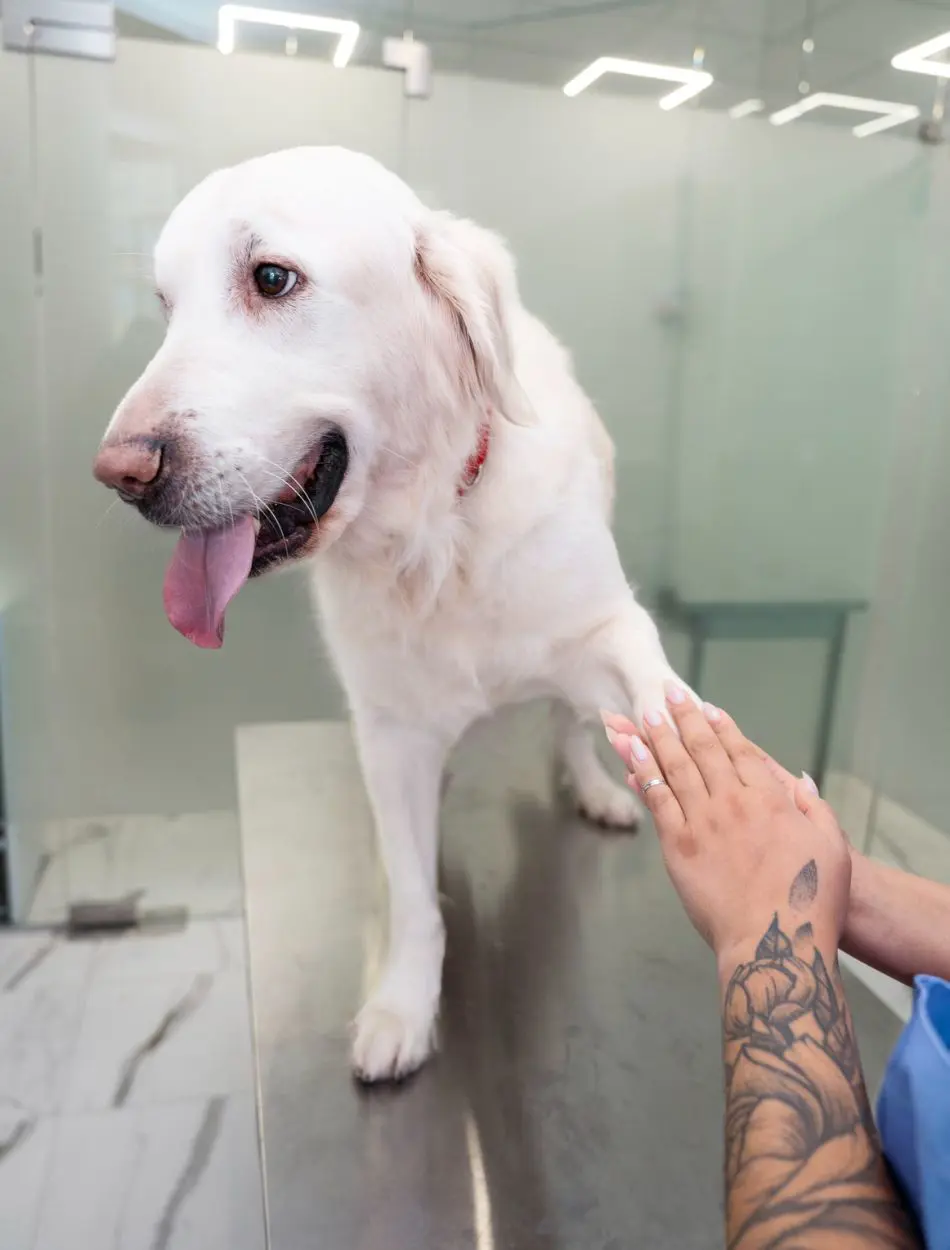How Can You Take A Dogs Temperature?

An increase in temperature may be a symptom of many health issues that, by right, one should know how to measure. By conducting regular checks for temperature, you provide yourself with an avenue to spot any potential problems before they become severe.
In this article, you will learn with ease how to take the temperature of your dog in a few simple steps to always keep their well-being in check. It helps ensure your dog will always be healthy and happy.
When To Check Your Dog’s Temperature
Monitoring the temperature of your dog at times becomes a very vital procedure in the canine context. Here are the five major signs and conditions reflecting that the right time to take their temperature has arrived.
Shows Distress and Discomfort
It would be a good idea to take their temperature if your dog appears in lots of distress or unease, such as with their eyes open and agitated. Sometimes these distress calls can be an early warning signal that you're dealing with an animal developing an illness or fever.
You will have a better sense of what is wrong with your dog and thus know how to further care for them.
Appearance of Blood Vessels in the Eyes
When the blood vessels in your dog's eyes appear easier to see than they usually would, this can be an indication that your dog's temperature is too high or they are in a stressed state. Sometimes this discoloration will also lead to their body fighting something on the inside.
You may want to confirm this by checking their temperature for confirmation if it is higher than it should be and taking care of the concern.
Hot Skin to Touch
If your dog's skin feels hotter than it usually would when you touch them, this is a sign of fever or overheating. Adding that to some of the other more surface-level signs of discomfort would serve to show their temperature has risen.
This helps you take their temperature to understand if urgent action is required to cool them down or consult with a veterinarian.
Increased Panting
Heavy panting might indicate overheating or some health problem. If the poor dog is panting heavily and looks disturbed, then his temperature could give important clues about the status.
This will help in diagnosing possible problems such as heat stroke and other medical concerns that may call for timely treatment.
Dark Red Gums
Dark red gums are a symptom of fever or even serious illness. In this case, being able to take your dog's temperature when you develop this symptom may give you an idea if this is something serious.
You need to act fast because dark red gums usually denote that your dog needs to see a medical professional or some intervention to avoid certain health complications.
Choosing the Right Thermometer

It is important to choose the right thermometer when taking your dog's temperature correctly, the use of digital thermometers is recommended because they are faster and rather accurate.
In addition, a thermometer designed for pets should be used for comfort and precision, avoid the use of glass thermometers since they easily break and may expose your pet to harm. The preferred ones are digital models with flexible tips because this provides a less discomforting way for the pet.
The quicker it responds, the quicker you get your reading and the less time your dog will have to remain still. It is also advisable to have a thermometer for your dog to avoid any cross-contamination.
Preparing Your Dog For A Temperature Take
Put your dog in a quiet and comfortable spot and the first thing to do with your dog is to relax him; this can be done by speaking softly and stroking. This way, you get the job done with ease, which would be a lot less stressful for both of you.
Then, have on hand and ready to go all of the things you may want or need a thermometer among them, and some positive reinforcement treats. Introduce your dog slowly to the thermometer by allowing him to sniff the device.
In truly nervous dogs, it may be helpful to have another person hold them and reassure them. It is far less intimidating for the animal, and thus less risk of someone getting hurt in the process.
Make A Room For A Stress-Free Check
First of all, one has to create around him that is as calm as possible in preparation for the procedure of temperature taking. Take him to a quiet room in which he feels secure and safe from distractions and noise.
The atmosphere must be as gentle as possible to assist your dog in reducing his anxiety. Make sure the room is well-lit so that you can see well, but not super bright to the point that it will make your dog nervous.
Have all the supplies you may need within sight and reach a thermometer, a lubricant such as petroleum jelly, and some treats to give your dog afterward. This will prevent you from having to get up and cause your dog more distress.
Positioning Your Dog Correctly

Correct positioning of your dog is one of the requirements for the accurate and safe taking of his temperature. You shall allow your dog to either stand or lie down, whichever he is comfortable with.
Have your dog on a standing surface for stability and let him not stand on a slippery surface for this may cause slipping and hurt him. He should be on his side for easy access. The positioning will be such that you are comfortable and secure in taking his temperature without giving him distress.
To steady your dog, both gentle and firm handling should be used. If with one hand, rest on the back or side to support, while with the other insert the thermometer.
The rule of thumb is to keep your dog as calm and still as possible, because otherwise, it may get tough to get a proper reading due to sudden jerky movements.
Lubricant for Comfortable Experience
Take a little petroleum jelly and grease the tip of the thermometer with it, this reduces friction and hence makes the insertion easier and less distressing for your dog. In this respect, lubrication of a rectal thermometer will prevent irritation of the very device itself.
Use a lubricant that is non-toxic to pets, but not excessive, since this makes the thermometer slippery and difficult to handle. A little, even an application should help make things easy and comfortable.
This little step goes a very long way in ensuring that the experience is as non-traumatic and pain-free as possible. If you properly prepare the thermometer for a few minutes, then your dog will remain relaxed and composed throughout the experience.
Insertion Technique
Taking the temperature of your dog involves one thing-insertion technique, that is, correctness and safety, lifting your dog's tail so that you can see the rectal area without any blockade, and inserting the greased thermometer into the canal, making sure you do it very slowly and steady, going in about an inch in.
Keep the thermometer in place for the duration recommended by the manufacturer-usually a few seconds in the case of digital thermometers. That way, you can ensure that the thermometer doesn't wobble around and give you some faulty readings.
After the time has elapsed, slowly and carefully remove the thermometer then read the temperature immediately, correct placement means correct recording of the temperature while bringing minimal discomfort to your dog.
Reading the Temperature

The normal temperature of a dog generally lies between 101° to 102.5° Fahrenheit. A reading in that range suggests your dog is in a state of normal temperature. However, a temperature reading that is a little outside this range may be alarming for your dog and require extra attention or care.
If it were above or below that range, then you really should be watching your dog carefully for signs of any other kind of distress or bizarre behavior. That temperature would be too high or too low to raise suspicions that maybe something isn't quite right.
Knowing what your dog's temperature reading is will ultimately enable you to act appropriately and right on time when such a need arises.
Cleaning And Storing The Thermometer Properly
Wash the thermometer first with warm water, using mild soap to take out any residue remaining inside, take a disinfectant wipe or rubbing alcohol, and go over the thermometer real nice and thorough, ensuring all bacteria have been killed.
Cleaning properly avoids the buildup of germs and will make sure that the thermometer is safe to use next time. Dry the thermometer entirely when cleaned. The moisture can grow bacteria, so keep the thermometer in a dry and clean place.
If there is a protective case for it, store it in that case and further keep it in a separate place where it won't be utilized by anyone else or for anything else.
Rewarding Your Dog After the Process
Give your dog a treat or extra attention afterward, because good reinforcement means repeat behavior. Positive reinforcement gives the dog the ability to relate the process of taking a temperature with something pleasant and anxiety will be minimized over time.
Immediately after taking his temperature, reward your dog or involve him in his favorite activity, such as brief play or snuggle time. This shifts the attention away from the little irritation he has just been exposed to and converts this into a rewarding session.
Immediately after the temperature is taken, make sure to do something that he loves, for this sets a pattern in his head. You are making this process less painful and stressful for you and your dog by continually rewarding him through this process.
When to Seek Professional Help

If the temperature happens to be too high or too low, or if your dog happens to be in acute distress, then you should immediately consult a veterinarian. This will ensure from professional guidance that your dog is on proper treatment and will detect the problem further back.
If one may doubt the accuracy of their readings or what to make of them, a visit to the vet will clear some things up. Your veterinarian is also pretty well-placed to give you some useful hints about taking the temperatures better at home, so you can feel confident in knowing that you're not missing anything.
When you get that feeling of uncertainty, never hesitate to call in a vet-most times, such a professional's input will make all the difference in your dog's health.
Digital Versus Mercury Thermometers For Dogs
In most instances, when it comes to measuring the temperature of your dog, a digital thermometer is preferred. They are quick to provide readings and can also be flexible at the tip, which can make the whole process comfortable for your pet.
Several digital models boast memory that stores previous readings, and this makes noting changes over time pretty easy. They are really easy to use and generally have designs made for pets, so rest assured they'll keep your pet safe and content.
They require more careful handling to avoid breakage and the exposure of mercury. The rigid design may even further give your dog some discomfort, digital thermometers offer safer and more practical solutions for most owners and are the best choice for routine temperature checks.
How Age Affects Your Dog's Body Temperature

As your dog ages, age will affect his body temperature, puppies have systems that are immature and make them further predisposed to the extremes of temperature. In their small size and further developing physiology, puppies can be challenged in both hot and cold temperatures.
With older dogs, there is a problem in regulating temperature due to the reduced metabolic rates and arthritis accompanying it. This will make the reactions of the body to changes in temperature not as fast as usual, and special attention needs to be given to the ambiance surrounding them.
The monitoring of temperature can help in managing such issues and in keeping older dogs healthy and feeling comfortable. This will provide better care, along with appropriate responses to your dog in his life with an understanding of age-related changes.
Recent posts
Dogs
Why Is My Dog Sneezing? 18 Common Reasons
You may notice that your dog sneezes and have some curiosity about their well-being-as they would react to dust, pollen, or strong odors. Though sneezing can be as common in dogs as in humans, you need to determine whether it falls into playful, occa...
15 Causes of Dog Losing Hair
Occasional hair loss and shedding is a natural physical process in dogs. Seasonal shedding helps remove dead and excessive hair from their body. But, when a dog starts losing excessive hair, it can be a terrifying sight for pet owners. Often, dog par...
18 Signs A Dog is Dying
Recognizing the signs that a dog is dying can be heartbreaking, but it's far more essential to offer comfort in their final days. The signs consist of changes in behavior and constant hunger indicating that it may be time to say good-bye. Owners who...
17 Reasons Why Is Your Dog Whining
Canine whine can both endear and annoy dog owners. But have you ever wondered why your furry friend resorts to this vocal expression? From expressing their needs to communicating their emotions, a dog's whine can reveal a wealth of information about ...
18 Signs Of A Dogs Broken Leg
A dog's broken leg isn't always the most painful experience but additionally an unexpected disruption to their energetic way of life. Whether due to an unexpected coincidence or rough play, quick intervention is essential to prevent long-term complic...
18 Reasons Why Dogs Lick Your Feet
Dogs are fascinating creatures, and their behaviors can often amaze humans. One behavior that many dog owners notice is their canine companion licking their feet. It can be a sign of affection or a way for them to show acceptance. Licking is al...





